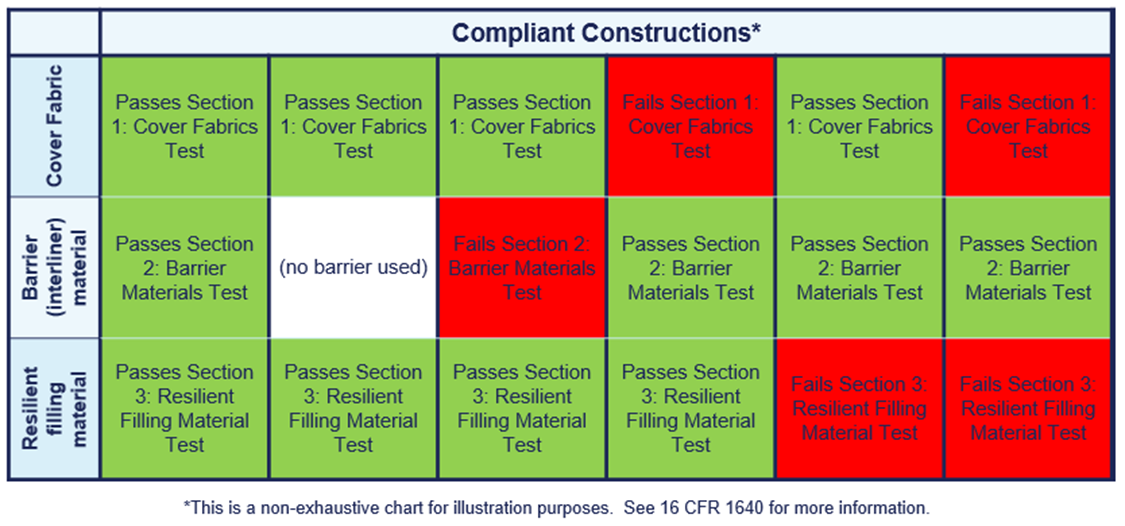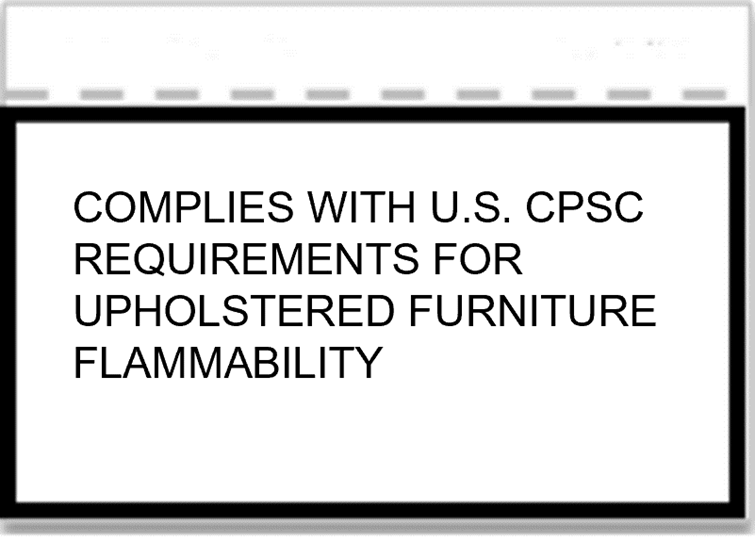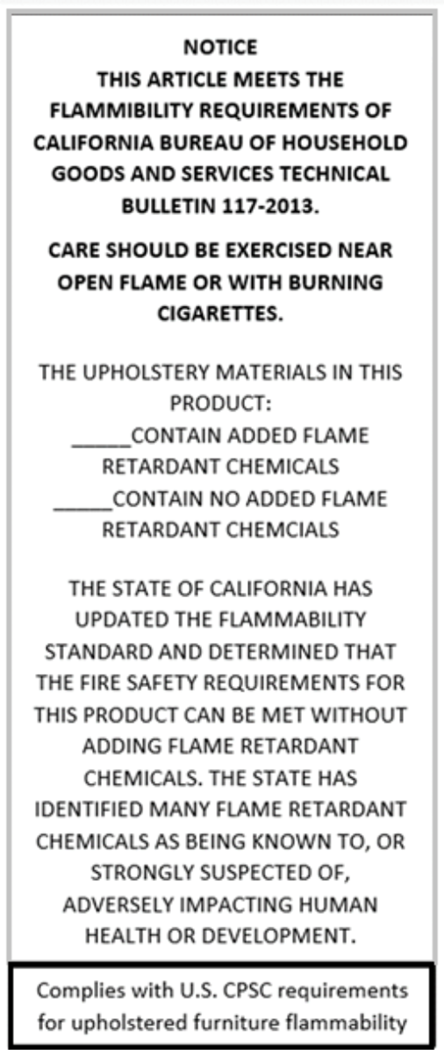The purpose of 16 C.F.R. part 1640 is to reduce deaths and injuries associated with upholstered furniture fires. This standard provides methods for smolder resistance of cover fabrics, barrier materials, resilient filling materials, and decking materials for use in upholstered furniture.
Enacted in 2020, the COVID-19 Regulatory Relief and Work From Home Safety Act establishes statutory flammability requirements for upholstered furniture. CPSC codified these requirements at 16 C.F.R. part 1640.
or more information on the Flammable Fabrics Act (FFA), visit our FFA business guidance page.
“Upholstered furniture” is defined at 16 C.F.R. § 1640.3(e) as an article of seating furniture that:
- is intended for indoor use;
- is movable or stationary;
- is constructed with an upholstered seat, back, or arm;
- is:
- made or sold with a cushion or pillow, without regard to whether that cushion or pillow, as applicable, is attached or detached with respect to the article of furniture; or
- stuffed or filled, or able to be stuffed or filled, in whole or in part, with any material, including a substance or material that is hidden or concealed by fabric or another covering, including a cushion or pillow belonging to, or forming a part of, the article of furniture; and
- together with the structural units of the article of furniture, any filling material, and the container and covering with respect to those structural units and that filling material, can be used as a support for the body of an individual, or the limbs and feet of an individual, when the individual sits in an upright or reclining position;
- includes an article of furniture that is intended for use by a child;
- does not include—
- A mattress;
- A foundation;
- Any bedding product; or
- Furniture that is used exclusively for the purpose of physical fitness and exercise.
Additionally, under Title 4 of California Code of Regulations § 1374.2, codified in 16 C.F.R. § 1640.5(b), the following products are exempt from meeting the flammability requirements for upholstered furniture:
- Cushions and pads intended solely for outdoor use;
- Certain products with no more than ½” of filling material;
- Certain children’s products, including bassinets, booster seats, car seats, changing pads, floor play mats, highchairs, highchair pads, infant bouncers, infant carriers, infant seats, infant swings, infant walkers, nursing pads, nursing pillows, playpen side pads, play yards, portable hook-on chairs, and strollers; and
- Products obtained by a written prescription from a healthcare professional.
16 C.F.R. part 1640 (except for the requirement to include a certification label), went into effect on June 25, 2021. Items manufactured, imported, or reupholstered on or after June 25, 2021, must comply with the test method specified in California Standard Technical Bulletin (TB) 117-2013. The labeling requirement in 16 C.F.R. § 1640.4 went into effect on June 25, 2022, and the requirement applies to upholstered furniture manufactured, imported, or reupholstered on or after that date.
Under 16 C.F.R. part 1640, upholstered furniture must comply with the requirements in TB 117-2013. TB 117-2013 has four test methods for cover fabric, resilient filling material, barrier material, and decking material. To determine if they pass their respective test, each component is evaluated against three performance criteria for char length, smoldering, and transition to open flaming. Upholstered furniture can meet the requirements of TB 117-2013 by having a passing barrier material that completely surrounds the filling material, or by having a passing cover fabric and a passing filling material. If decking material is present, it must pass the decking material test.
Examples of compliant constructions under 16 C.F.R. part 1640 are illustrated in the chart below:

16 C.F.R. part 1640 incorporates by reference TB 117-2013, as originally published in June 2013. A later version of TB 117-2013, dated January 2019, reflects the name change of BEARHFTI to Bureau Household Goods and Services (BHGS) on the cover page, but it is otherwise identical to the June 2013 version. As such, either the June 2013 or January 2019 version may be used. However, future revisions of TB 117-2013 will not change 16 C.F.R. part 1640 unless the Commission issues a direct final rule to incorporate such an update.
Under 16 C.F.R. § 1640.4(b), upholstered furniture subject to the standard must have a permanent label with the language: “Complies with U.S. CPSC requirements for upholstered furniture flammability." CPSC staff recommends that the certification statement be conspicuous and legible. The statement should be at least 1/8-inch high and not smaller than other text on the label and should be in black text on a white background that is surrounded by a black border. The label may be a separate label, or it can be added to the bottom of an existing California TB 117-2013 label required by SB-1019. The required statement must appear on the front of the label in English and cannot be on the back side of the label. However, additional languages may be on the back side of the label.
Example of Separate Label:

Example of Combined Label:

The label must be affixed securely to the article of upholstered furniture so that the label will remain attached throughout conditions of merchandising and distribution to the ultimate consumer. It is recommended that the label should be located prominently on the product and be conspicuous to the consumer. Hangtags and zip ties are not considered permanent labels.
California requires disclosure of any flame retardant under SB-1019 for upholstered furniture. The labeling requirement under 16 C.F.R. § 1640.4(b) is in addition to any other labeling requirements imposed by law, including the state of California’s labeling requirements.
A General Certificate of Conformity (GCC) is not required to demonstrate compliance with 16 C.F.R. part 1640. Manufacturers, importers, and re-upholsterers are only required to have a certification label with the statement: “Complies with U.S. CPSC requirements for upholstered furniture flammability.” However, upholstered furniture may need to comply with additional CPSC testing requirements, such as lead in paint, or children’s product testing for lead and/or other applicable requirements, which subsequently would require compliance with the certification requirement.
Under 16 C.F.R. part 1640, the only labeling requirement is to provide the label with the certification statement: “Complies with U.S. CPSC requirements for upholstered furniture flammability." A best practice is to maintain records for at least as long as the product remains in production.
Yes, re-upholsterers are responsible for ensuring that products they reupholster comply with 16 C.F.R. part 1640.
CPSC does not provide lists of components that pass their respective tests in TB 117-2013 to comply with 16 C.F.R. part 1640.
TB 117-2013 specifies the ignition source as SRM 1196 or a cigarette which meets the specifications listed in Table 1 of Annex B. SRM 1196a has been shown to be equivalent to 1196 and meets the specifications listed in Table 1 of Annex B of TB 117-2013.
Barrier materials used for compliance must pass the TB 117-2013 Section 2 test. Barrier material must fully encase the resilient filling material, except for limited exceptions, discussed in Section 2.1, for non-reversible and non-detachable seating cushions. TB 117-2013 Section 2.1 states: “Upholstery cover fabrics that fail the cover fabric test described in Section 1 can be used in upholstered furniture if a barrier (interliner) material that passes this test method is used. When a barrier is required, the barrier material must cover all sides and top of the seating cushion(s).” Similarly, section 3.1 states: “Resilient filling materials that fail the test...can be used in upholstered furniture if a barrier (interliner) material that passes Section 2 of this test method is used between the cover fabric and the filling materials.”
The TB 117-2013 Section 1 test applies to cover fabrics and cover materials, such as fabric, leather, vinyl, and other woven, knit and nonwoven materials used as the outermost layer in an in-scope upholstered furniture article. TB 117-2013 Section C.2 describes “upholstery cover material” as “the outermost layer of fabric or related material used to enclose the main support system or upholstery materials, or both, used in the furniture item.”
The definition of “upholstered furniture” does not include mattresses at 16 C.F.R. § 1640.3(e)(3)(i). Mattresses are subject to 16 C.F.R. parts 1632 and 1633. If the mattress portion of the futon and/or sofa bed is detachable, the detached mattress is likely only subject to the flammability standards in 16 C.F.R. parts 1632 and 1633. The rest of the futon and/or sofa bed after the mattress is detached is likely subject to 16 C.F.R. part 1640. If the mattress portion of the futon and/or sofa bed is permanently attached to the rest of the product, the product as a whole is likely subject to 16 C.F.R. part 1640.
For more information about mattress, mattress pad, and mattress set requirements, visit this FAQ page.
Small, decorative, throw pillows that are sold separately and are not intended for seating are not included within the scope of 16 C.F.R. part 1640. Cushions or pillows that are sold separately and are intended for indoor seating would likely be considered within the scope of 16 C.F.R. part 1640, unless they do not meet the definition of “upholstered furniture” at 16 C.F.R. § 1640.3(e) or are otherwise exempted under Title 4 of California Code of Regulations § 1374.2, codified in 16 C.F.R. § 1640.5(b).
Reupholstered furniture, including antiques, must comply with 16 C.F.R. part 1640 if the furniture is reupholstered for sale. Any furniture that is reupholstered for sale, or intended for sale, either by the reupholster or the owner of the furniture who hires the services of the re-upholsterer, must comply with the regulation. If the furniture is reupholstered for personal use, it is not subject to the requirements. Personal use includes when the person who reupholsters the furniture intends to retain the reupholstered furniture for their own use, or if a customer hires the services of the re-upholsterer and the customer intends to take back the reupholstered furniture for their own use after reupholstery.
Yes. Cover fabrics and resilient filling materials which have been added to in-scope reupholstered furniture need to meet the requirements of TB 117-2013. The re-upholsterer is not responsible for ensuring that originally used cover fabrics and resilient filling materials which have not been added in the re-upholstery process are compliant with the flammability requirements.
16 C.F.R. § 1640.5(b) codifies the preemption provisions, which preempts states and other jurisdictions from establishing or continuing in effect their own flammability regulations designed to protect against the risk of occurrence of fire, or to slow or prevent the spread of fire, with respect to upholstered furniture. There is no preemption for any state or local law, regulation, code, standard, or requirement that concerns other health or safety risks.
16 C.F.R. part 1640 does not include a chemical composition requirement. There are many different types of materials that can meet their respective tests in TB 117-2013 (i.e., cover fabrics, barrier materials, resilient filling materials, and decking materials with and without added flame-retardant chemicals). The requirements do not specify or prohibit the use of flame-retardant chemicals to meet the requirements.
For information on CPSC’s other work related to organohalogen flame retardants (OFRs), visit this guidance page.
CPSC staff hosted an educational webinar on the CPSC’s flammability requirements for upholstered furniture, and interested parties can view a full recording here. Additional materials, including a presentation in simplified Chinese, are available on this podcast episode: “Episode 16: U.S. Flammability Requirements for Upholstered Furniture.”
Yes. There are general requirements for child care articles, defined at 16 C.F.R. § 1307.2, and children’s product that may apply:
- Lead in paint and similar surface coatings: Children’s products must not bear paint and/or similar surface coatings that contain more than 0.009 percent (90 ppm) lead.
- Examples include painted component parts (e.g., buttons, zippers, snaps), printing processes that use a liquid or semi-liquid surface coating that hardens (e.g., screen printing)
- Total lead content: Children’s products must not contain greater than 100 ppm (0.01 percent) of total lead content in any accessible component part.
- Examples include component parts (e.g., buttons, zippers, snaps), heat transfer vinyl, metallic threads/fibers
- The Commission determined that textiles (excluding those that contain treatments or applications that do not consist entirely of dyes) are not required to be tested for total lead content. More information is available on our total lead content business guidance page.
- Phthalates: Children’s toys and child care articles must not contain greater than 0.1 percent (1000 ppm) of any regulated phthalate in any accessible component part.
- Examples include plasticized component parts, certain screen-printing inks
- Third-party testing: Children’s products must be tested for compliance with applicable safety rules by a third-party, CPSC-accepted laboratory.
- Children’s products in continuous manufacture are also subject to periodic testing requirement.
- Certification: Domestic manufacturers or importers of children’s products must generate a Children’s Product Certificate (CPC) certifying compliance to the applicable safety rules and ensures that a CPC accompanies the distribution of the product.
- CPCs are not required to include “16 CFR part 1640” in the list of citations.
- Tracking label: Children’s products must bear distinguishing, permanent marks on the product and any packaging that allow consumers to ascertain the identity of the manufacturer or private labeler, date and place of manufacture, detailed information on the manufacturing process (i.e., batch or run number), and the specific source of the product (e.g., address of the specific manufacturing plant).

